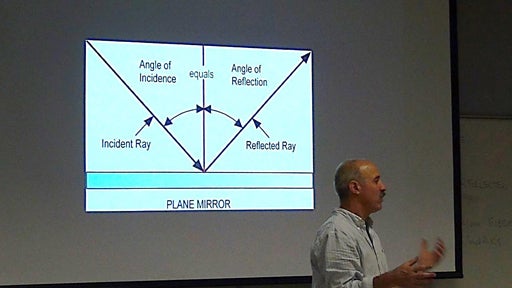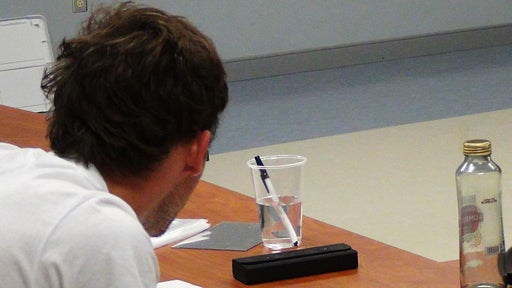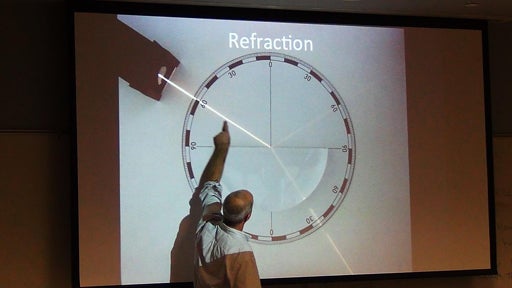Promoting Student Engagement: Utilizing Student Exploration as a Means of Information Synthesis
Contents
Introduction
At Appalachian State University (ASU), Mr. Jeff Goodman uses a model known as the 5E Instructional Model to introduce scientific concepts to his students. This model helps frame instructional practices for teaching course content in the following sequence: engagement, exploration, explanation, elaboration, and evaluation.
He describes his rationale in using the method:
In terms of outcomes, I want my students to be people who are more curious than they were at the beginning, who think that the content that I thought is inherently fun and accessible, that they can hold onto and know at some level.
Mr. Goodman has been ASU for 20 years, and is currently teaching in the College of Education. He took one year to teach high school, and spends one day a week in his wife’s middle school classroom “trying to see if this stuff actually pans out – and it’s hard!”
UDL Alignment
Each College STAR module will explain how a particular instructional practice described within the module aligns with one or more of the principles of UDL. For this module, the focus will be on Provide Multiple Means of Engagement, Principle III.
Module Alignment with Provide Multiple Means of Engagement
Mr. Goodman uses fantasy to illustrate physics concepts to his students. He actively engages students in a fictional story and has them contribute to the process and outcome of the story, which integrates the physics principals in the curriculum. In his practice, Mr. Goodman utilizes the BSCS 5E instructional model which offers students opportunities to abstract and elaborate the principal from the fantasy story, into a real application. This type of student engagement offers opportunities to the students to truly synthesize the information from an engaging story, into the real life application and useful knowledge.
Instructional Practice
The first two stages (engagement exploration) of the 5E Instructional Model are exemplified in the previous module, Cultivating Learner Attention and Engagement. Mr. Goodman initially engaged his students by promoting their interest in a law of physics through situational factors such as humor and fantasy with the Kingdom of Light story. He then enabled them to explore that law of physics by manipulating lasers and mirrors, encouraging them to solve a problem from that story.
From Concrete Demonstration to Abstraction
Since the Kingdom has been set right again, Mr. Goodman asks his class to then help the princess write an article or draw a diagram, (whichever choice is more meaningful to them,) for the fictional kingdom’s newspaper about how she escaped from the dungeon. Mr. Goodman has students write about what the scientific principle is and how it behaves so that the light reflects off of a mirror and the Princess escapes. This activity embodies the explanation phase of the 5E model.

Figure 1: Mr. Goodman’s visual representation of the principal of laser reflection.
After the students have articulated the scientific definition of light refraction in a way that is meaningful to them, through a drawing or worded summary, Mr. Goodman enters the elaboration phase where he asks them to re-apply the principle to a new physical task. He explains:
We started with a physical task, we developed an idea, then we encoded it in a written piece or maybe a diagram, we tried it out, and then I keep doing things to see if they’re thinking it all the way through. I take a piece of mirror and I hold it so that they can’t see it, and I say, ‘I’m going to flip this around. What will you see?’ and everyone makes a prediction. We’re using the abstraction for a new task. Then I’ll have them re-apply it to another new task, like how light refracts in water—a new medium.

Figure 2: Student observing refraction when a pen is in water.
Mr. Goodman gives students multiple ways to test the principle of refraction for themselves though another hands-on demonstration and offers access to diagrams and photographs. Through this new medium, students’ understanding of the law of refraction is not only challenged, but reinforced and supported by further connection to the physical world. Mr. Goodman describes his practice:
I want them to be able to take an idea and apply it to a new situation so it’s not just, ‘Whenever you have a princess and a rat and a vat of acid, the best thing to do is…’—but I want to see that they own the material because I can see that they’ve taken it and applied it to something new rather than just staying with the story that I put out there. I try hard to set up opportunities for them to do that, for them to produce things. I hate teaching something if they feel like they can’t use it.

Figure 3: Mr. Goodman demonstrating the principal of refraction on the board.
Summary
In summary, providing various resources and challenges not only continues to capture attention, but also stimulates learner concentration and effort. The evaluation phase is continual and expansive beyond the classroom, and Mr. Goodman explains how the strategy behind this lesson is a part of his larger pedagogy of teaching:
If you follow that pattern, there’s an engagement (the story), there’s an exploration (manipulating the lasers and mirrors), there’s an explanation that we work on together (name the principle and definition), and then we try it out and expand it. All along, I’m evaluating. In everything I do, I have this idea, which is to engage people, to get them to want to solve a problem, to let them mess with real materials, to develop an abstraction, to try the abstraction on something new, and to evaluate how that’s all working the whole time.
Mr. Goodman’s application of the 5E Model in his classroom exemplifies the UDL principal to provide multiple means of engagement. Mr. Goodman asks his students to express a physics principal which contributes to synthesis of knowledge. Through elaboration, Mr. Goodman facilitates abstraction of a principal, then application of the principal, which lead to student’s complete understanding and knowledge. By using the 5E Model, Mr. Goodman engages his students through different activities and provides multiple paths for successful learning.
Learn More
Literature Base
Editor’s Note: The Literature Base section of each College STAR module provides a brief summary of support for the Instructional Practice in the module. This is not an exhaustive literature review. It is designed to give the viewer an introduction to the literature about the module Instructional Practice. Please consider using the Learn More section of the module to supplement the information you obtain through this Literature Base summary.
The BSCS 5E Instructional Model serves the purpose of aiding students in their formulation of scientific concepts and consists of the following phases: engagement, exploration, explanation, elaboration, and evaluation. The model walks learners through a sequential process. At first, by engaging their prior knowledge, students become curious. They are then led to experience the subject matter hands-on, through which they generate their own personally meaningful explanation of that experience, and apply that in a new scenario. Finally, students are encouraged to self and peer evaluate while simultaneously being evaluated by the instructor for learning and class goals (Bybee et al., 2006).
One definition of student engagement is “participation in educationally effective practices, both inside and outside the classroom, which leads to a range of measurable outcomes” (Harper & Quaye, 2009, p. 2).
The efficacy of this strategy can be further understood by exploring a theory of Lev Vygotsky’s, an early 20th century developmental psychologist. He defined a learner’s zone of proximal development as the difference between what a learner can accomplish independently and with developmentally appropriate scaffolding. He suggested that since different learners will require different levels and amounts of support, they should work together on tasks in an effort to amplify the learning process and foster higher-level thinking (Vygotsky, 1962, 1978).
One way to accommodate the variety of learning styles and need for different learning supports of today’s learners is to facilitate group or partner work on substantive tasks in the classroom. Additionally, these activities should have correlates to real-world situations outside the classroom. Research has tied higher education academic performance and satisfaction closely with involvement with faculty and peers around such tasks that promote higher-order thinking (Light, 1992).
References & Resources
Bybee, R., Taylor, J. A., Gardner, A., Van Scotter, P., Carlson, J., Westbrook, A., Landes, N. (2006). The BSCS 5E Instructional Model: Origins and Effectiveness. Colorado Springs, CO: BSCS.
CAST (n.d.) About CAST: What is Universal Design for Learning. Retrieved from http://cast.org
CAST (2009). CAST UDL Online Modules. Retrieved from http://www.cast.org
EnACT. (n.d.) 14 common elements of UDL in the college classroom.
Evans, C., Williams, J. B., King, L., & Metcalf, D. (2010). Modeling, guided instruction, and application of UDL in a rural special education teacher preparation program. Rural Special Education Quarterly, 29(4), 41-48.
Retrieved from Education Research Complete
Harper, S. and Quaye, S. (Eds.). (2009). Student engagement in higher education: Theoretical perspectives and practical approaches for diverse populations. New York: Routledge.
Immordino-Yang, M., & Damasio, A. (2007). We feel, therefore we learn: The relevance of affective and social neuroscience to education, Mind, Brain & Education, 1(1), 3-10. doi: 10.1111/j.1751-228X.2007.00004.x
http://dx.doi.org/10.1111/j.1751-228X.2007.00004.x
Light, R. J. (1992). The Harvard Assessment Seminars: Second report. Harvard University School of Education.
Liu, T.-C., Peng, H., Wu, W.-H.,& Lin, M.-S. (2009). The effects of mobile natural- science learning based on the 5E learning cycle: A case study. Educational Technology & Society, 12 (4), 344–358
National Center on Universal Design for Learning. (2011). About UDL. Retrieved from http://www.udlcenter.org/aboutudl
Rose, D., & Dalton, B. (2009). Learning to read in the digital age. Mind, Brain & Education, 3(2), 74-83. doi:10.1111/j.1751-228X.2009.01057.x
http://dx.doi.org/10.1111/j.1751-228X.2009.01057.x
Rose, D. H., Harbour, W. S., Johnston, C. S., Daley, S. G., & Abarbanell, L. (2006). Universal design for learning in postsecondary education: Reflections on principles and their application. Journal of Postsecondary Education & Disability, 19(2), 135-151.
Retrieved from Education Research Complete.
Rose, D. H. & Meyer, A. (2002). Teaching every student in the digital age: Universal design for learning. Alexandria, VA: Association for Supervision and Curriculum.
Retrieved from http://www.cast.org/
UDLCAST. (2011, October 7). Introduction to UDL [Video file]. Retrieved from http://www.youtube.com/watch?v=MbGkL06EU90&feature=relmfu
Vygotsky, L. (1978). Mind in society: The development of higher psychological processes. Cambridge, MA: Harvard University Press.
Additional Resources
APA Style: A DOI primer. (2009). Retrieved from http://blog.apastyle.org/apastyle/2009/09/a-doi-primer.html
Boddy, N., Watson, K. and Aubusson, P. (2003). A Trial of the Five Es: A referent model for constructivist teaching and learning. Research in Science Education 33(1): 27-42.
Bonwell, C.C. and Eison, J.A. 1991. Active learning: Creating excitement in the classroom. ASHE-ERIC Higher Education Report 1. Washington, D.C. George Washington University.
CAST: Center for Applied Special Technology. (1999-2013). Retrieved from http://www.cast.org
CrossRef. (2013). DOI Resolver. Retrieved from http://crossref.org
International DOI Foundation. (2012). Resolve a doi number. Retrieved from http://www.doi.org
Drach-Zahavy, A., & Erez, M. (2002). Challenge versus threat effects on the goal–performance relationship. Organizational Behavior and Human Decision Processes, 88(2), 667-682.
Ebrahim, A. (2004). The effects of traditional learning and a learning cycle inquiry learning strategy on students’ science achievement and attitudes toward elementary science (Kuwait). Dissertation Abstracts International 65(4): 1232.
Folkman, S., Lazarus, R. S., Dunkel-Schetter, C., DeLongis, A., & Gruen, R. J. (1986). Dynamics of a stressful encounter: Cognitive appraisal, coping, and encounter outcomes. Journal of Personality and Social Psychology, 50(5), 992-1003.
Hedegaard, M. (1996). The Zone of Proximal Development as basis for instruction. In H. Daniels (Ed.), An introduction to Vygotsky (pp. 171–195). London: Routledge.
Johnson, D. W., & Johnson, R. T. (1999). Learning together and alone: Cooperative, competitive, and individualistic learning. Boston, MA: Allyn & Bacon.
Marzano, R. J., Pickering, D. J., & Pollock, J. E. (2001). Classroom instruction that works: Researched-based strategies for increasing student achievement. Virginia: Association for Supervision and Curriculum Development.
National Research Council (NRC). (2005). How Students Learn: Science in the Classroom. M. S. Donovan and J. D. Bransford (Eds). Washington, DC: National Academies Press.
Ohta, A. S. (1995). Applying sociocultural theory to an analysis of learner discourse: Learner-learner collaborative interaction in the Zone of Proximal Development. Issues in Applied Linguistics, 6(2), 93-121.
Smallwood, B. (2009). CLASSE: Classroom Survey of Student Engagement. Overview.
Retrieved February 3, 2011 from: http://www.assessment.ua.edu/CLASSE/Overview.htm
Stahl, E., Pieschl, S., & Bromme, R. (2006). Task complexity, epistemological beliefs and metacognitive calibration: An exploratory study. Journal of Educational Computing Research, 35(4), 319-338.
Strangman, N. (2002). Collaborative internet projects: An interview with Susan Silverman about her passion and hobby. Reading Online, 5(6).
Retrieved on May 27, 2009, from http://www.readingonline.org/articles/voices/silverman/.
Topping, K. J. (2005). Trends in peer learning. Educational Psychology, 25(6), 631-645.
Trowler, V. (2010). Student engagement literature review. Lancaster University.
Retrieved fromhttp://www.heacademy.ac.uk/assets/documents/studentengagement/StudentEngagementLiteratureReview.pdf
Vygotsky, L. S. (1962). Thought and language. Cambridge, MA: MIT Press.
Zimmerman, B. J., Bonner, S., Kovach, R. (1996). Developing self-regulated learners: Beyond achievement to self-efficacy. Psychology in the classroom: A series on applied educational psychology. Washington, DC, US: American Psychological Association. viii 147 pp.
doi: 10.1037/10213-000
http://psycnet.apa.org/books/10213
About the Author

Jeff Goodman
Curriculum & Instruction
Appalachian State University